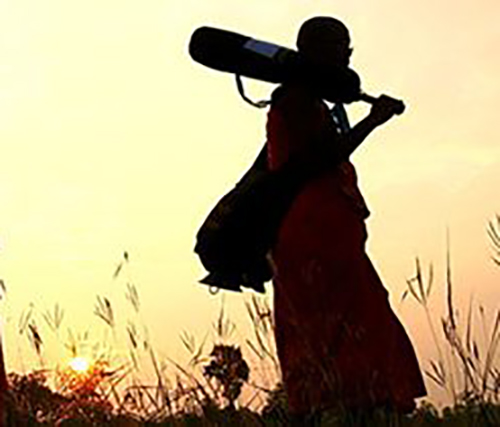
From that time onwards Candasaro devoted himself entirely to the study of meditation. Leaving the comforts of a fixed abode behind, he became a wandering bhikkhu and undertook 'dhutanga', a practice of austerity and self-purification to develop detachment from material things and to deepen the practice of meditation. Dhutanga was a practice embraced by forest monks who wished to live the holy life. These monks would spend weeks or months, or even years, in the forests or remote provinces, with nothing more than an umbrella doubled as a tent and a few other necessary requisites.
When his older sister knew of his intention to undertake dhutanga, she had a dhutanga umbrella1 (klod) made for him (1Dhutanga umbrella (klod): an umbrella doubled as a tent under which a dhutanga monk uses as a shelter to practice meditation and to sleep). Candasaro left for the provinces, returned after a short period, and gave away the umbrella to another bhikkhu. Later he made a second dhutanga trip, and again received an umbrella from his aunt. (Giving a dhutanga umbrella to a dhutanga monk is considered a great merit. Candasaro wanted his aunt to have this merit.)
Candasaro came upon many interesting encounters during his dhutanga adventures. He met many monks who had taken dwellings in the forest. Some of them possessed great insight and wisdom. Others possessed supernatural powers. While trekking in a forest in Sukhothai, he met a forest monk who applied the mantra "samma arahang" in his meditation practice. This was the first time Candasaro heard these words. They were to play an important part in the meditation technique that he later perfected.
Once, during his second dhutanga excursion, he arrived at a semi-deserted temple, Wat Phrasrirattanamahathat, in Suphanburi. The atmosphere there seemed peaceful and conducive to meditation. He decided to camp there. As he was getting ready to set up his umbrella some children drove a herd of oxen into the area.
"Don't let the cows come any further, or you may incur bad kamma for yourselves," he cautioned them. The children paid no attention to him and made an impolite remark, thinking this monk wanted to have the whole area for himself.
Pointing to a specific spot on the ground Candasaro said to them, "There are Buddha images under the ground here. If you don't believe me, try digging here and see for yourselves." The children were curious. They dug at that spot. After a few strokes of the shovel they found several Buddha images buried underneath. The children were awestruck. They paid respect to Candasaro and apologized to him for their impolite behavior. News of Candasaro's psychic power traveled.
The half-deserted temple was in bad shape. There were over a hundred Buddha images, large and small, left in ruins. Many were vandalized. Some with heads cut off or arms missing. Candasaro felt something should be done to return the temple to a useful state. He organized a meditation class and invited the locals to participate. Many attended. Candasaro took the occasion to explain to the locals the benefits associated with the restoration of a temple. He sought their help with the repair work. Many agreed to help. The number of people gradually grew to a large size.
It was an uncommon occurrence in rural Suphanburi at that time that a large number of good-hearted people would join together and extend their helping hands to restore a ruined temple. Progress began to take shape. Unfortunately, the large congregation attracted the prying eyes of the Suphanburi authorities. They were fearful that the large gathering might lead to a civil unrest or an uprising. The authorities went to see Somdej2 Phra Wanarat (Pearn Tissadatto) of Wat Phra Chetuphon (2Somdej: a high-ranking monastic title), who was the monastic governor of the area at that time, and urged him to summon Candasaro to leave the area. To show respect for the authorities, Candasaro complied.
He then moved on to Wat Songpinong. While at Wat Songpinong he established a school for Dhamma scholars and also spearheaded the formation of a foundation to provide funds for education. Later, he moved back to Wat Phra Chetuphon.
While at Wat Phra Chetuphon he became acquainted with Venerable Nok, Abbot of Wat Bote-bon, Bangkuvieng District, Nonthaburi. He made frequent visits to Wat Bote-bon to see Luangpor Nok, who often invited him to deliver sermons on his behalf.
Wat Bote-bon was situated in a forest environment with many trees on the temple grounds. The environment was peaceful and conducive to meditation. During Candasaro's days of scriptural study, its previous abbot, Venerable Choom, had provided him with many Buddhist texts. As a way to repay his kindness, Candasaro was desirous of moving to Wat Bote-bon to teach the monks, novice monks, and laypeople there. He went to pay respect to Somdej Phrabuddhajahn, then the Abbot of Wat Phra Chetuphon, and left to spend his rains retreat at Wat Bote-bon, Bangkuvieng. This was in 1917.
After eleven years of practice with some of the best Thailand had to offer, Candasaro still felt he had not yet attained the ultimate knowledge realized by the Buddha. He studied Visuddhimagga, the Path of Purity, a scriptural text on meditation practice, and proceeded to pursue meditation on his own.